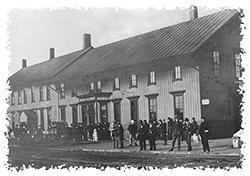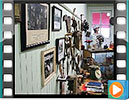 |
CRAWFORD COUNTY HISTORICAL SOCIETY |
|
|---|---|---|
On-line Museum Tour | ||
Preserving the heritage and artifacts of Crawford County | ||
97 E. Michigan Ave, PO Box 218, Grayling, MI 49738 989-348-4461 | ||





Click image to view each video
 Depot (lobby) |
 Depot |
 Depot (rear) |
 Lumber Display |
 Sheriff's Display |
 Bear Archery |
 Upstairs Hallway |
 DNR Room |
|---|
 The Trapper's Wife |
 One Room Schoolhouse |
 General Store |
 Women's Business Room |
 Seamstress Room |
 Medical Room |
 Saloon |
|---|
Click images for full size photos
 Diesel Engine |
 Ticket Window |
 Crossing Sign |
 River Display (1) |
 River Display (2) |
 River Display (3) |
 Canoe Marathon |
|---|
 Riverboats |
 1915 Riverboat |
 Depot Agent |
 Skingley House |
 1890's Kitchen |
 RR Artifacts |
 Local Artifacts |
|---|
 Wood Stove |
 Logging Display 1 |
 Logging Display 2 |
 Logging Display 3 |
 Sheriff Display 1 |
 Sheriff Display 2 |
 Bear Archery (1) |
|---|
 Bear Archery 2 |
 Bear Archery 3 |
 Logging Photos |
 Upstairs Hallway |
 DNR Room |
 Trapper's Wife |
 Schoolhouse |
|---|
 Medical Display |
 1900 Telephone |
 Saloon Display |
 Business Women 1 |
 Business Women 2 |
 General Store |
 Entertainment |
|---|
Return to Yesterday...
|
Take an imaginary trip back in time by touring the Crawford County Historical Museum complex. Visitors will take a nostalgic trip to the turn of the century in the restored Passenger Freight Depot which was built in 1882. In its heyday, there were seven northbound passenger trains and five southbound trains as well as freight trains, all of which went through Grayling daily. On approaching the depot, the visitor will notice the brick waiting platform, which has witnessed the pounding of many feet. The intricate work of laying the bricks must have taken many hours. The ticket office now contains the operations center of the museum, but the guest can still experience the vicarious thrill of purchasing a ticket for that first steam engine ride. The ticket window counter and grillwork have been left intact. From the ticket window, the visitor can view the tools of the lumberman and the photos of his history, reflecting an era when Grayling had great fame as a leading lumbering center. Many of the early buildings in this nation were constructed using the pine from forests around this area. The historical display of the famous Au Sable River reveals its uses from the early days of the Native Americans to its present day use of fishing and canoeing. An original 1915 riverboat hangs suspended from the lobby ceiling while photos of men who built and guided the riverboats are exhibited. A section of the display tells the story of the AuSable Canoe Marathon Race begun in 1947, which has become an international event. Grayling was named for the fish which was so plentiful in the cold, clear waters of the Au Sable. Back in the mid 1800s, men came from Europe and Scandinavia to fish for the well-known grayling guided by men like Rube Babbitt Sr. and Chief Shoppenagon. Later, trout were to become the key fish in a sport that beckoned the tourist. As early as 1914, local sportsmen began the Fish Hatchery to restock trout in the nearby streams. It was the forerunner of modern fisheries management. The Fish Hatchery has now been restored and trout are being raised there specifically for the visitor to view. The hatchery is operated by the Grayling Recreation Authority. Venture upstairs in the depot where separate rooms show life as it was for a trapper's wife, a seamstress, and a doctor. Rooms are also dedicated to the one-room schoolhouse, a grocery store, old-fashioned entertainment, Fred Bear memorabilia, a saloon, and a sheriff's display. Another room is furnished as a bunk room for the railroad crew which was the original use of the second floor. The DNR room holds photos of the winter sports park which is now called Hanson Hills. One can see the snow train which would bring thousands of enthusiasts from Detroit to the park for a fun-filled weekend of winter sports. There is also a showcase displaying winter carnival and snow queen memorabilia. Today, Hanson Hills still offers skiing, tubing and snowshoeing as well as summer sports. Adjacent to the museum, a 1929 railroad caboose will allow the visitor to answer the lifelong question: what exactly is in a caboose, that cute little car that tags along at the end of a train? This caboose is a veteran of thousands of miles of service along the Detroit to Mackinaw run. It was the "home away from home" for the train crewmen. The Museum Annex (small white building) was built in the 1870s, the first schoolhouse in Grayling. It later became the Township Hall. It now houses an impressive military display dating back to the Civil War. Included are areas depicting a typical barracks and supply room. The Annex also contains a photo display of the history of Camp Grayling, a National Guard facility. The camp was begun in 1913 through a gift of land from local lumber baron, Rasmus Hanson. Guard personnel from Michigan train here annually, as do members of the Ohio and Indiana National Guard. Many other units have taken advantage of the unique facilities at the camp and its far-flung maneuvering areas. The fire hall in the museum complex, constructed by members of the Grayling City and Township Fire Departments, houses two fire engines. The 1922 model T Ford is said to be the first ever used at Camp Grayling and is on permanent loan to the museum from the 746th Battalion. Sgt. Major Chris Beauchamp and Sgt. First Class Terry Rood were instrumental in reconditioning the vehicle. The 1937 Chevy fire truck is a Champion Fire Engine made by W.S. Darley and Co., of Chicago. It was the city's first fire truck. The small rustic cabin is an old trapper's cabin which was built in the 1800s by a trapper living in Houghton Lake. One can see various pelts and tools, and can gain an idea of how his cabin was furnished, enabling him to exist during the cold winter months. The agricultural barn houses farm implements of the early years of Crawford County as well as a set of pictures depicting many of the earliest farms. There is also an eye-catching cutter that is over 100 years old and a 1949 tractor, both of which are on loan to the museum. Our county is not an agricultural area, in spite of the glowing reviews given it in the early years of settlement. Practically all of the farms are no longer in existence. Purchases can be made at the gift shop located in the lobby of the depot. There are many railroad and depot items to choose from as well as limited-edition prints of famous historic locomotives and train cars created by well-known local artists. Personnel at the museum are volunteers who are enthusiastic about the history of this area and will answer any questions they can about the early years. The museum is operated on the basis of donations, receiving no funds from any unit of government. The membership fee in the Historical Society is one of the sources of funding. New members are welcome and will be contributing to the repair and restoration of the buildings and to the further development of displays at the museum site. |
NEW!! June 2014 Newsletter
Train information page – See photos of the 2007 Train Event
|
Get free Adobe Acrobat
 Reader to read .pdf newsletters Reader to read .pdf newsletters |
|---|